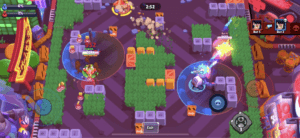
Title: Comparative Analysis of Brawl Stars’ Hot Zone and “Cold War Capture the Flag” Game Modes
Brawl Stars is a mobile game that has numerous game modes to choose from. One of these game modes in particular involves very similar mechanics to our game while also containing important differences to examine. It’s called Hot Zone, where two teams compete to control a designated area on the map called the “Hot Zone.” The winning team is the one that crosses the point threshold first or stays in the Hot Zone for the longest. The flag, or the Hot Zone, is essentially what you are “capturing,” but the game doesn’t finish there; you also have to defend the flag for a set period of time.
Our game is split into Americans and Soviets, each aiming to defend their own flag while capturing the other team’s. The addition of “spies,” who are covertly assigned to a different side and attempt to undermine their purported comrades, gives the game a novel twist. The spies’ goal is to secure both flags at the halfway line by bringing the seized flags there.
Similarities:
In “Cold War Capture the Flag,” teams must plan to seize the enemy’s flag while defending their own. In Hot Zone, teams must coordinate their efforts to keep control of the assigned zone. Each team’s potential to win depends on its ability to plan strategically, communicate, and adjust to the game’s constantly shifting dynamics. The designated zone in Hot Zone appears at random points on the map, requiring teams to respond fast and modify their plans as necessary. Similarly, the players in our in game can decide where to play, add terrain specifications (such as the quicksand area), and choose where to place their flag. In addition, the spy element of deception adds uncertainty, as players must constantly question the loyalty of their teammates. This psychological aspect deepens the strategic complexity of the game and challenges everyone to read their opponents and make split-second decisions.
Differences:
One of the main differences that our game has is the spy system, which completely alters team dynamics. Spies need to carefully walk the delicate balance between maintaining their cover and seizing the opportunity to strike and bring about the opposing teams’ downfall. In addition, our game also has specific player roles (president and detective), each having distinct abilities that can significantly impact team strategy. The president has the power to instate a fallen spy as a member of their own team, while the detective can investigate an opposing player to uncover their true allegiance. Another key difference lies in the elimination and revival mechanics present in both games. For us, if a player is eliminated, they are sent to a “prison” area, as opposed to what happens with Hot Zone, where players immediately respawn in their respective areas. This adds a layer of risk and reward that forces players to weigh the benefits of mounting a rescue mission against the potential dangers of leaving their flag unguarded.
Overall, our game introduces a range of unique elements that set it apart and add some complexity that isn’t a part of the core gameplay of Hot Zone. However, Playing Hot Zone has given me perspective into addressing some potential areas for improvement, though. This includes balancing, map design, visual clarity, and player onboarding.



